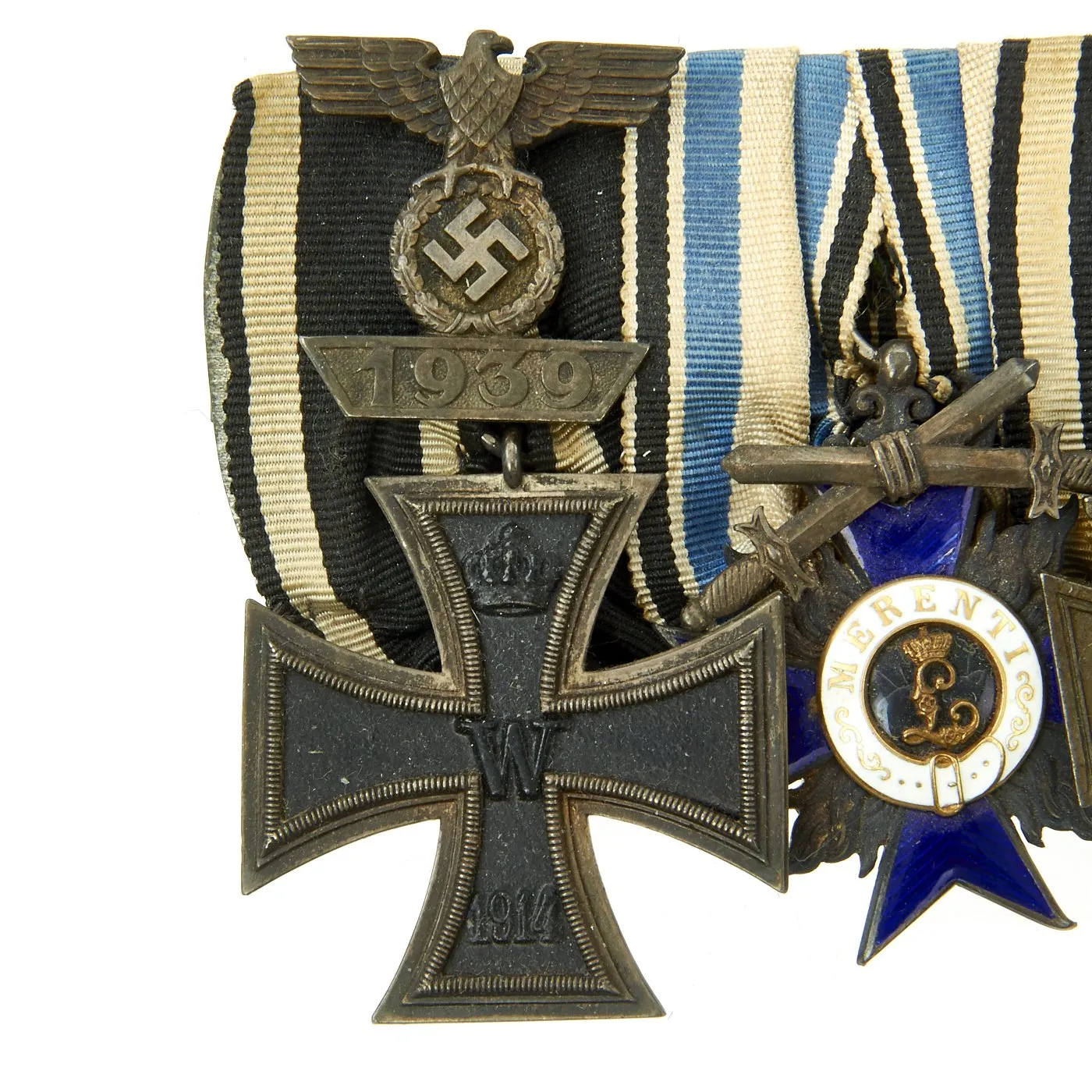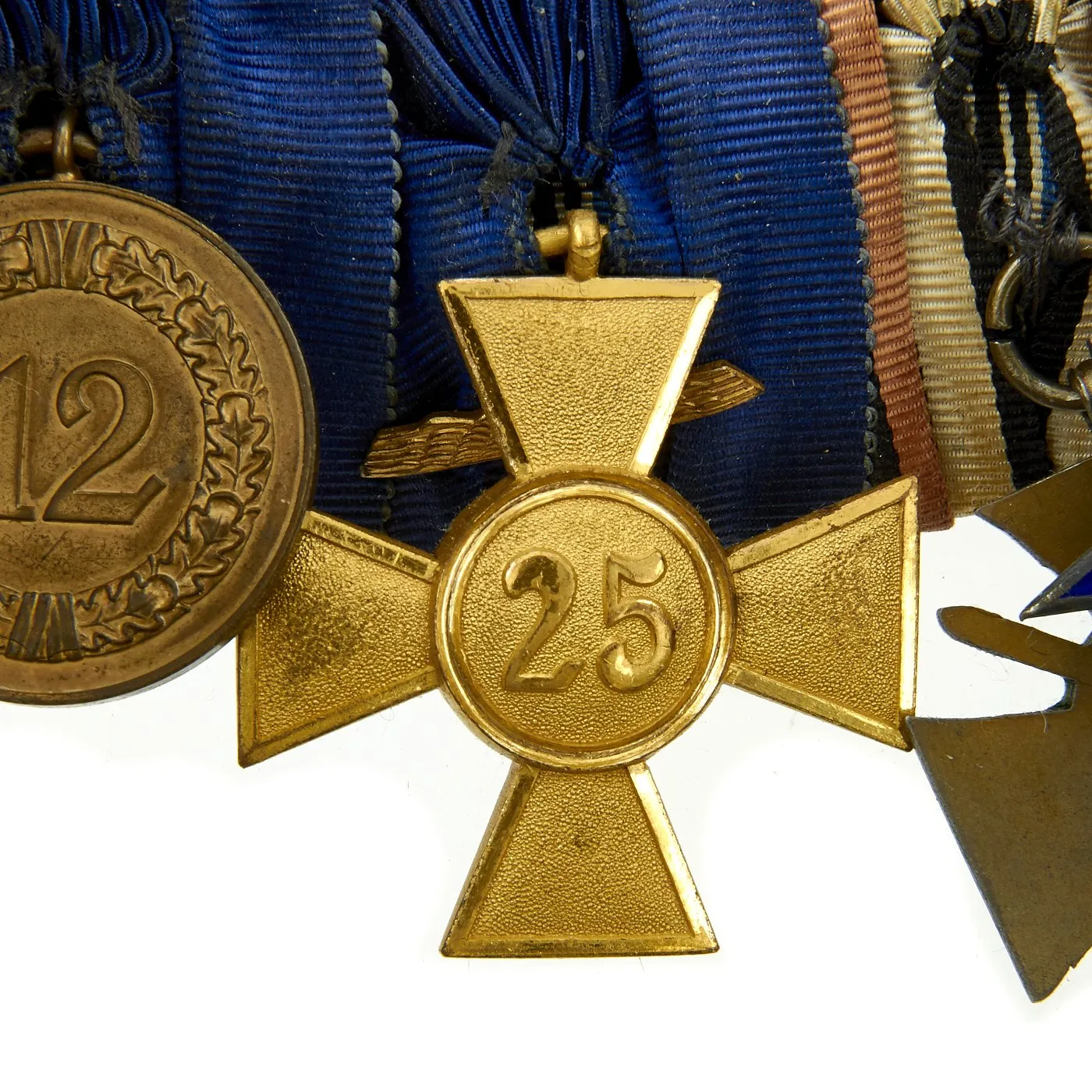Original Item: One-of-a-kind. This is fantastic a 100% genuine medal bar removed from the uniform of a fallen or captured German soldier during WWII and brought home by an American soldier as a war trophy. The German soldier served in World War One and was highly decorated then he served again in WW2. The set of 5 medals consists of the following:
- WWI Iron Cross 2nd Class (Eisernes Kreuz 2. Klasse, or EKII) with 1939 Clasp (Spange) for Second Award
- Bavarian Merenti Cross of Military Merit with Swords, 1st Class, 1866.
- WWI Honor Cross of the World War 1914/1918 (Hindenburg Cross) with Crossed Swords
- WWII Wehrmacht 25 Year Long Service Award (Gold)
- WWII Wehrmacht 12 Year Long Service Award (Gold)
- WWII Anschluss Commemorative Medal
- WWII Sudetenland Medal (Czech Conquest)
Iron Cross 2nd Class with 1939 Clasp:
Emperor Wilhelm II reauthorized the Iron Cross on 5 August 1914, at the start of World War I. During these three periods, the Iron Cross was an award of the Kingdom of Prussia, although - given Prussia's pre-eminent place in the German Empire formed in 1871 - it tended to be treated as a generic German decoration. The 1813, 1870, and 1914 Iron Crosses had three grades.
The Iron Cross 1st Class and the Iron Cross 2nd Class were awarded without regard to rank. One had to possess the 2nd Class already in order to receive the 1st Class (though in some cases both could be awarded simultaneously). The egalitarian nature of this award contrasted with those of most other German states (and indeed of many other European monarchies), where military decorations were awarded based on the rank of the recipient. For example, Bavarian officers received various grades of that Kingdom's Military Merit Order (Militär-Verdienstorden), while enlisted men received various grades of the Military Merit Cross (Militär-Verdienstkreuz). Prussia did have other orders and medals which it awarded on the basis of rank, and even though the Iron Cross was intended to be awarded without regard to rank, officers and NCOs were more likely to receive it than junior enlisted soldiers.
With so many Iron Crosses issued in WWI, it was inevitable that soldiers who already had achieved the 1914 version of the award might receive another during WWII. When the 1939 Iron Cross began being issued, they also introduced the Clasp to the Iron Cross (Spange zum Eisernen Kreuz). This way, a holder of the 1914 Iron Cross could be awarded a second or higher grade of the 1939 Iron Cross. To permit the two medals to be worn together, a "1939 Clasp" (Spange) would be worn on the original 1914 Iron Cross. It depicted a national eagle clutching an oak leaf wreath surrounding a swas above a trapezoid bearing the year 1939. The clasp was attached to the 1914 Iron Cross medal ribbon. The ribbon was then worn through a tunic button of the uniform.
Bavarian Merenti Cross of Military Merit with Swords, 2nd Class, 1866.
Order of Military Merit was instituted in 1866 in 5 Classes. In 1905 the Cross of Military Merit was revised initially to 2 Classes and in 1913 to 3 classes. Each class was awarded according to the rank of the recipient and could be issued with or without swords (for peace or war time period) and crown (for a 2nd award). The old non-enameled 2nd Class became the 3rd Class and was changed from silver to bronze. The old 1st Class became the 2nd Class. The new 1st Class was identical to the 2nd Class except that it was gilt rather than silver.
This is the First class award, indicating it was received by a higher ranking officer, and the swords indicate it was awarded during wartime.
Hindenburg Cross with Crossed Swords (for combat)
The Honor Cross of the World War 1914/1918 (German: Das Ehrenkreuz des Weltkriegs 1914/1918), commonly, but incorrectly, known as the Hindenburg Cross was established by Field Marshal Paul von Hindenburg, President of the German Republic, by an order dated 13 July 1934, to commemorate the distinguished deeds of the German people during the First World War. This was Germany's first official service medal for soldiers of Imperial Germany who had taken part in the war, and where they had since died it was also awarded to their surviving next-of-kin. Shortly after its issuance, the government of NSDAP Germany declared the award as the only official service decoration of the First World War and further forbid the continued wearing of German Free Corps awards on any military or paramilitary uniform of a state or NSDAP Party organization.
Wehrmacht Long Service Award - 12 and 25 Years:
This award was a military service decoration of NSDAP Germany issued for satisfactory completion of a number of years in military service. The award itself is in fact both medals, as the service was cumulative, so after the 4th class, both a cross and a medal were worn, and the color indicated service.
On 16 March, 1936, Adolf AH ordered the institution of service awards for the first four classes, each reflecting the completion of a select number of years of military service.
Each branch of the Wehrmacht (army, navy, and air force) maintained their own version of the Long Service Award and the decoration was issued for four years (silver medal – fourth class), 12 years (gold medal – third class), 18 years (silver cross – second class), 25 years (gold cross – first class), and 40 years (1939 special class). The 40 years special class service award was introduced on 10 March 1939.
Professor Dr Richard Klein designed the awards. Recipients of lower year awards would wear the decoration simultaneously with higher level decorations. The manner they could be worn was:
3rd Class with 4th Class (gold medal with silver medal)
2nd Class with 4th Class (silver cross with silver medal)
1st Class with 3rd Class (gold cross with gold medal)
The Long Service Award was retroactive throughout a service member's career, encompassing Reichswehr service as well as service dating during and before World War I. As such, there were a handful of 40 year awards presented, even though the NSDAP era only lasted 12 years (1933-1945).
Anschluss Commemorative Medal
(German: Die Medaille zur Erinnerung an den 13. März 1938) was a decoration of NSDAP Germany awarded in the interwar period. Instituted on 1 May 1938, the medal commemorated the annexation of Austria to the German Reich, the so-called Anschluss. The move was the first in AH's quest for Lebensraum, and it strengthened German flanks while weakening those of Czechoslovakia. German troops crossed the border on 12 March 1938, without any resistance. The medal, known as the "Anschluss medal", was awarded to all persons, both military and civilian, who contributed to or participated in the annexation. It was also awarded to German State officials and members of the German Wehrmacht and SS who marched into Austria. It was awarded until 31 December 1940, and a total of 318,689 medals were awarded.
The round, highly detailed, die-struck medal was based on the 1938 Party Day Badge and designed by Professor Richard Klein. On the obverse of the medal, symbolic of becoming part of the German realm, a man holding the NSDAP flag stands on a podium bearing the eagle emblem of the "Third Reich"; he assists onto the podium a second man, on whose right hand a broken shackle is seen. On the reverse is the inscription "13. März 1938" (13 March 1938), the date of the Anschluss. The date is surrounded on the outer edge by the words, "Ein Volk, Ein Reich, Ein Führer" ("One People, One Empire, One Leader"). It is suspended from a red ribbon with white-black-white stripes at the edges of the ribbon.[5] It was made of brass or tombak bronze with a silvered matte finish.
1 October 1938 Commemorative Medal
(German: Die Medaille zur Erinnerung an den 1. Oktober 1938) Commonly known as the Sudetenland Medal, this was a decoration of NSDAP Germany awarded in the interwar period. Instituted on 18 October 1938, the medal was awarded to German military personnel who participated in the occupation of Sudetenland and the occupation of Czechoslovakia in March 1939.
The medal was awarded to all German (and as well Sudeten) State officials and members of the German Wehrmacht and SS who marched into Sudetenland. Later it was awarded to military personnel participating in the occupation of the remnants of Czechoslovakia on 15 March 1939. It was awarded until 31 December 1940. In all 1,162,617 medals and 134,563 bars were awarded.
The medal was similar in appearance as the Anschluss Medal, the reverse only differed in the date. It was designed by Professor Richard Klein.





























